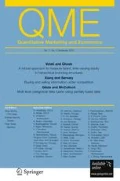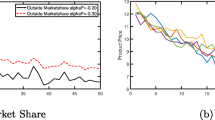Abstract
In models of demand and supply, consumer price sensitivity affects both the sales of a good through price, and the price that is set by producers and retailers. The relationship between the dependent variables (e.g., demand and price) and the common parameters (e.g., price sensitivity) is typically non-linear, especially when heterogeneity is present. In this paper, we develop a Bayesian method to address the computational challenge of estimating simultaneous demand and supply models that can be applied to both the analysis of household panel data and aggregated demand data. The method is developed within the context of a heterogeneous discrete choice model coupled with pricing equations derived from either specific competitive structures, or linear equations of the kind used in instrumental variable estimation, and applied to a scanner panel dataset of light beer purchases. Our analysis indicates that incorporating heterogeneity into the demand model all but eliminates the bias in the price parameter due to the endogeneity of price. The analysis also supports the use of a full information analysis.
Similar content being viewed by others
References
Allenby, G.M. and P.J. Lenk. (1994). “Modeling Household Purchase Behavior with Logistic Normal Regression”, Journal of the American Statistical Association 89, 1218-1231.
Allenby, G.M. and P. Rossi. (1999). “Marketing Models of Consumer Heterogeneity”, Journal of Econometrics 89, 57-78.
Berry, S. (1994). “Estimating Discrete-Choice Models of Product Differentiation”, Rand Journal of Economics 25, 242-262.
Berry, S., J. Levinsohn, and A. Pakes. (1995). “Automobile Prices in Market Equilibrium”, Econometrica 63, 841-890.
Chib, S. and E. Greenberg. (1995). “Understanding the Metropolis-Hastings Algorithm”, The American Statistician 49, 327-335.
Chintagunta, P., J.P. Dube, and K.Y. Goh. (2002). “Targeted Pricing and the Estimation of Consumer Choice Models in the Presence of Unmeasured Product Characteristics”, Working paper, University of Chicago.
Draganska, M. and D. Jain. (2002). “Structural Models of Competitive Market Behavior: An Estimation Approach Using Disaggregate Data”, Working paper, Stanford University.
Gelfand, A.E. and A.F.M. Smith. (1990). “Sampling-Based Approaches to Calculating Marginal Densities”, Journal of the American Statistical Association 85, 398-409.
Gelfand, A.E., S. Hills, A. Racine-Poon and A.F.M. Smith. (1990). “Illustration of Bayesian Inference in Normal Data Models Using Gibbs Sampling”, Journal of the American Statistical Association 85, 972-985.
Goolsbee, A. and A. Petrin. (2001). “Consumer Gains from Direct Broadcast satellites and the Competition with Cable TV”, Working Paper, The University of Chicago GSB.
Kuksov, D. and M. Villas-Boas. (2001). “Endogeneity and Individual Consumer Choice”, Working Paper, UC-Berkeley.
Manchanda, P., P. Chintagunta, and P.E. Rossi. (2003). “Response Modeling with Non-Random Marketing Mix Variables”, Working paper, Graduate School of Business, University of Chicago.
Nevo, A. (2001). “Measuring Market Power in the Ready-to-Eat Cereal Industry”, Econometrica 69(2), 307-342.
Newton, M.A. and A.E. Raftery. (1994). “Approximating Bayesian Inference with the Weighted Likelihood Bootstrap”, Journal of the Royal Statistical Society (B) 56, 3-48.
Petrin, A. and K. Train. (2002). “Omitted Product Attributes in Discrete Choice Models”,Working paper, UC-Berkeley.
Sudhir, K. (2001a). “Competitive Pricing Behavior in the Auto Market: A Structural Analysis”, Marketing Science, 20, 1, 42-60.
Sudhir, K. (2001b). “Structural Analysis of Competitive Pricing in the Presence of a Strategic Retailer”, Marketing Science 20(3), 244-264.
Tanner, M.A. and W.H. Wong. (1987). “The Calculation of Posterior Distributions by Data Augmentation”, Journal of the American Statistical Association 82, 528-550.
Villas-Boas, M. and R. Winer. (1999). “Endogeneity in Brand Choice Models”, Management Science 45, 1324-1338.
Villas-Boas, M. and Y. Zhao. (2003). “The Ketchup Marketplace: Retailer, Manufacturers, and Individual Consumers”, Working paper, UC-Berkley.
Villas-Boas, S.B. (2002). “Vertical Contracts Between Manufacturers and Retailers: An Empirical Analysis”, mimeo, University of California at Berkeley.
Author information
Authors and Affiliations
Corresponding author
Rights and permissions
About this article
Cite this article
Yang, S., Chen, Y. & Allenby, G.M. Bayesian Analysis of Simultaneous Demand and Supply. Quantitative Marketing and Economics 1, 251–275 (2003). https://doi.org/10.1023/B:QMEC.0000003327.55605.26
Issue Date:
DOI: https://doi.org/10.1023/B:QMEC.0000003327.55605.26



